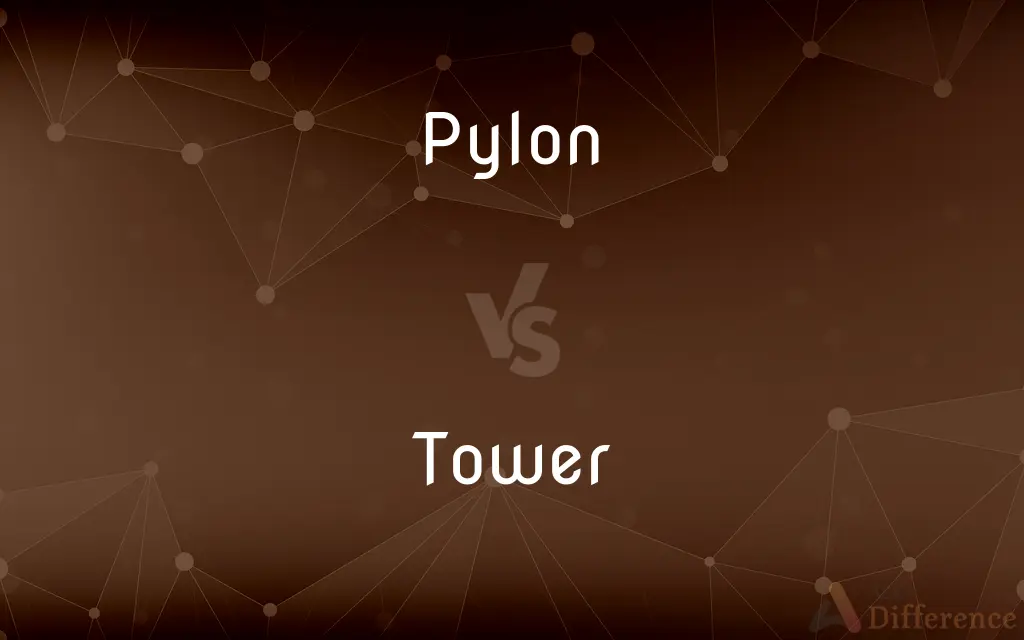Pylon vs. Tower — What's the Difference?
Edited by Tayyaba Rehman — By Maham Liaqat — Updated on April 8, 2024
A pylon is a structural support or gateway, often for electrical lines or bridges, while a tower is a tall structure, typically standing alone or as part of a building, used for observation or communication.

Difference Between Pylon and Tower
Table of Contents
ADVERTISEMENT
Key Differences
Pylons are structures designed to support something, such as electrical cables or bridges, with a primary function of utility and support. Towers, on the other hand, are tall, often slender structures built to stand out from their surroundings, used for various purposes including observation, communication, or as part of architectural designs.
Pylons are characterized by their functionality, often serving as critical infrastructure components in electrical transmission and distribution networks or as supports in bridge construction. Whereas towers are noted for their height and architectural significance, serving as landmarks, lookout points, or parts of castle fortifications.
While pylons are engineered for strength and minimal obstruction to the surroundings, allowing for the safe support and distribution of power lines or the suspension of bridges, towers are designed with an emphasis on height and stability, enabling them to fulfill a wide range of functions from historical defense mechanisms to modern telecommunications.
The design of pylons is primarily driven by engineering requirements, focusing on efficiency and the physical demands of the structure they support. In contrast, towers often incorporate aesthetic considerations, reflecting cultural, historical, or modern architectural values, making them significant urban or historical landmarks.
Pylons and towers both play crucial roles in modern infrastructure and architecture but differ significantly in purpose, design, and cultural impact. Pylons emphasize utility and structural support, especially in transportation and energy distribution, while towers focus on height, visibility, and a broader range of functions from defense to communication and observation.
ADVERTISEMENT
Comparison Chart
Definition
A structural support, often for power lines or bridges.
A tall structure, used for observation, communication, or as an architectural feature.
Primary Function
Support and utility, especially in infrastructure.
Observation, communication, architectural significance.
Design Focus
Engineering efficiency, strength, minimal environmental impact.
Height, stability, aesthetic and cultural significance.
Examples
Electrical transmission pylons, bridge support pylons.
Watchtowers, bell towers, broadcast towers.
Significance
Essential for electrical distribution and transportation infrastructure.
Cultural, historical landmarks, functional structures in telecommunication and defense.
Compare with Definitions
Pylon
Often unnoticed by the public, except when in close proximity.
The towering pylons became visible as we approached the bridge.
Tower
Often incorporates aesthetic values, making it a landmark.
The tower's intricate design and lighting make it a notable landmark at night.
Pylon
Primarily serves in utility and infrastructure for support.
Electrical pylons carry high-voltage power lines across the country.
Tower
Frequently becomes a cultural or historical landmark.
The medieval tower has been preserved as a historical monument.
Pylon
Key in energy distribution and bridge construction.
The construction of the pylons was a critical phase in the bridge project.
Tower
A tall structure, often part of a building, used for various purposes including observation and communication.
The ancient tower offered breathtaking views of the surrounding countryside.
Pylon
A structure designed to support or bear a load, often used for electrical cables or as part of bridges.
The new bridge's pylons were designed to withstand extreme weather conditions.
Tower
Can be a significant part of a building's design or stand alone.
The clock tower has become an iconic feature of the city's skyline.
Pylon
Engineered for strength, durability, and minimal obstruction.
The pylons were spaced evenly across the landscape, minimizing their environmental impact.
Tower
Serves a wide range of functions from historic defense to modern telecommunications.
The telecommunications tower is a key component of the region's communication network.
Pylon
A movable, brightly colored cone or shaft of rubber that is used to signal something to be avoided, such as a hazard or work zone on a roadway.
Tower
A tower is a tall structure, taller than it is wide, often by a significant factor. Towers are distinguished from masts by their lack of guy-wires and are therefore, along with tall buildings, self-supporting structures.
Pylon
(Football) A flexible, usually padded marker that stands upright at each corner of the end zone to facilitate judgments of close plays.
Tower
A tall, narrow building, either free-standing or forming part of a building such as a church or castle
The south-west tower is a wonderful example of late Gothic
Pylon
A tower marking a turning point in a race among aircraft.
Tower
A tall structure that houses machinery, operators, etc.
A control tower
Pylon
A steel tower supporting high-tension wires.
Tower
Rise to or reach a great height
He seemed to tower over everyone else
Pylon
A tower or shaft supporting a wind turbine.
Tower
(of a bird) soar to a great height, especially (of a falcon) so as to be able to swoop down on the quarry.
Pylon
A structure supporting a bridge deck.
Tower
A building or part of a building that is exceptionally high in proportion to its width and length.
Pylon
A large structure or group of structures marking an entrance or approach.
Tower
A tall, slender structure used for observation, signaling, or pumping.
Pylon
A monumental gateway in the form of a pair of tapered blocks serving as the entrance to an ancient Egyptian temple.
Tower
One that conspicuously embodies strength, firmness, or another virtue.
Pylon
A structure that attaches an aircraft engine to a plane's wing or fuselage.
Tower
(Computers) A computer system whose components are arranged in a vertical stack and housed in a tall, narrow cabinet.
Pylon
A gateway to the inner part of an Ancient Egyptian temple.
Tower
To appear at or rise to a conspicuous height; loom
"There he stood, grown suddenly tall, towering above them" (J.R.R. Tolkien).
Pylon
(electricity) A tower-like structure, usually one of a series, used to support high-voltage electricity cables.
Tower
To fly directly upward before swooping or falling. Used of certain birds.
Pylon
(architecture) A tall steel or concrete tower from which cables are strung.
Tower
To demonstrate great superiority; be preeminent
Towers over other poets of the day.
Pylon
A lighting mast; a freestanding support for floodlights.
Tower
A very tall iron-framed structure, usually painted red and white, on which microwave, radio, satellite, or other communication antennas are installed; mast.
Pylon
(aviation) A structure used to mount engines, missiles etc., to the underside of an aircraft wing or fuselage.
Tower
A similarly framed structure with a platform or enclosed area on top, used as a lookout for spotting fires, plane crashes, fugitives, etc.
Pylon
A starting derrick for an aeroplane.
Tower
A water tower.
Pylon
A post, tower, etc. as on an aerodrome, or flying ground, serving to bound or mark a prescribed course of flight.
Tower
A control tower.
Pylon
An obelisk.
Tower
Any very tall building or structure; skyscraper.
The Sears Tower
Pylon
A traffic cone.
Tower
(figuratively) An item of various kinds, such as a computer case, that is higher than it is wide.
Pylon
(American football) An orange marker designating one of the four corners of the end zone in American football.
Tower
(informal) An interlocking tower.
Pylon
(medicine) A rigid prosthesis for the lower leg.
Tower
(figurative) A strong refuge; a defence.
Pylon
A low tower, having a truncated pyramidal form, and flanking an ancient Egyptian gateway.
Massive pylons adorned with obelisks in front.
Tower
(historical) A tall fashionable headdress worn in the time of King William III and Queen Anne.
Pylon
An Egyptian gateway to a large building (with or without flanking towers).
Tower
(obsolete) High flight; elevation.
Pylon
A tower, commonly of steelwork, for supporting either end of a wire, as for a telegraph line, over a long span.
Tower
The sixteenth trump or Major Arcana card in many Tarot decks, usually deemed an ill omen.
Pylon
Formerly, a starting derrick (the use of which is now abandoned) for an aeroplane.
Tower
(cartomancy) The nineteenth Lenormand card, representing structure, bureaucracy, stability and loneliness.
Pylon
A tower for guiding pilots or marking the turning point in a race
Tower
One who tows.
Pylon
A large vertical steel tower supporting high-tension power lines;
Power pylons are a favorite target for terrorists
Tower
(intransitive) To be very tall.
The office block towered into the sky.
Tower
(intransitive) To be high or lofty; to soar.
Tower
To soar into.
Tower
A mass of building standing alone and insulated, usually higher than its diameter, but when of great size not always of that proportion.
Tower
A citadel; a fortress; hence, a defense.
Thou hast been a shelter for me, and a strong tower from the enemy.
Tower
A headdress of a high or towerlike form, fashionable about the end of the seventeenth century and until 1715; also, any high headdress.
Lay trains of amorous intriguesIn towers, and curls, and periwigs.
Tower
High flight; elevation.
Tower
To rise and overtop other objects; to be lofty or very high; hence, to soar.
On the other side an high rock towered still.
My lord protector's hawks do tower so well.
Tower
To soar into.
Tower
A structure taller than its diameter; can stand alone or be attached to a larger building
Tower
Anything tall and thin approximating the shape of a column or tower;
The test tube held a column of white powder
A tower of dust rose above the horizon
A thin pillar of smoke betrayed their campsite
Tower
A powerful small boat designed to pull or push larger ships
Tower
Appear very large or occupy a commanding position;
The huge sculpture predominates over the fountain
Large shadows loomed on the canyon wall
Common Curiosities
Can pylons be considered architectural features?
While primarily functional, pylons can have distinctive designs, but they are not typically considered architectural features in the way towers are.
What role do pylons play in infrastructure?
Pylons are crucial for supporting electrical transmission systems and bridges, ensuring the distribution of electricity and the stability of bridge constructions.
What is the significance of tower design in modern architecture?
Modern towers often reflect technological advancements and architectural innovation, contributing to the skyline and identity of cities.
Why are towers often used as landmarks?
Their height, design, and historical significance make them stand out as cultural and navigational landmarks.
How do pylons impact the environment?
While designed to minimize physical and visual impact, pylons can affect landscapes and ecosystems, especially in sensitive areas.
Can pylons be artistic?
Some modern pylons have been designed with aesthetic considerations, blending functionality with artistic or environmental themes.
How do towers contribute to telecommunications?
Communication towers are essential for broadcasting, mobile phone networks, and other forms of wireless communication.
What is a pylon?
A structural support used mainly in infrastructure, such as for power lines or bridges.
What distinguishes a tower from a pylon?
Towers are primarily tall structures used for observation, communication, or as architectural features, whereas pylons are support structures for utility purposes.
What materials are commonly used to construct pylons?
Steel and concrete are the most common materials, chosen for their strength and durability.
Is there a difference in maintenance between pylons and towers?
Yes, the maintenance varies based on their construction, purpose, and location, with towers often requiring more complex upkeep due to their height and functionality.
Are there historical examples of towers?
Yes, many historical towers such as watchtowers, lighthouses, and bell towers have played significant roles in defense, navigation, and community life.
How are towers integrated into urban planning?
Towers are carefully planned to enhance the city's layout, aesthetics, and functionality, often becoming focal points of urban design.
What is the tallest tower in the world?
As of my last update, the Burj Khalifa in Dubai holds the title, but it's always a good idea to check for any new developments.
What future innovations are expected in the design of pylons and towers?
Innovations may include sustainable energy generation, advanced materials for greater durability, and designs that better integrate with natural and urban environments.
Share Your Discovery

Previous Comparison
Encompass vs. Embrace
Next Comparison
Beggar vs. BegarAuthor Spotlight
Written by
Maham LiaqatEdited by
Tayyaba RehmanTayyaba Rehman is a distinguished writer, currently serving as a primary contributor to askdifference.com. As a researcher in semantics and etymology, Tayyaba's passion for the complexity of languages and their distinctions has found a perfect home on the platform. Tayyaba delves into the intricacies of language, distinguishing between commonly confused words and phrases, thereby providing clarity for readers worldwide.















































